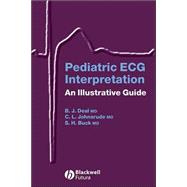
Dr. Christopher L. Johnsrude, MD. Associate Professor of Pediatrics, Director of Electrophysiology, University of Louisville School of Medicine
| Acknowledgements, | 6 | (1) | |
| Introduction, | 7 | (9) | |
| Normal ECGs, | 16 | (24) | |
| Abnormal ECGs, | 40 | (20) | |
| Acquired Heart Disease, | 60 | (28) | |
| Congenital Heart Disease, | 88 | (34) | |
| Bradycardia and Conduction Defects, | 122 | (32) | |
| Supraventricular Tachycardia, | 154 | (48) | |
| Ventricular Arrhythmias, | 202 | (38) | |
| Pacemakers, | 240 | (17) | |
| Appendix 1: Age-related normal ECG values in children, | 257 | (1) | |
| Appendix 2: Criteria for distinguishing VT from SVT, | 258 | (1) | |
| Appendix 3: Location of accessory atrioventricular connection using initial delta wave polarity, | 259 | (1) | |
| Appendix 4: Indications for pacing in childhood, | 260 | (1) | |
| Index, | 261 |
The New copy of this book will include any supplemental materials advertised. Please check the title of the book to determine if it should include any access cards, study guides, lab manuals, CDs, etc.
The Used, Rental and eBook copies of this book are not guaranteed to include any supplemental materials. Typically, only the book itself is included. This is true even if the title states it includes any access cards, study guides, lab manuals, CDs, etc.